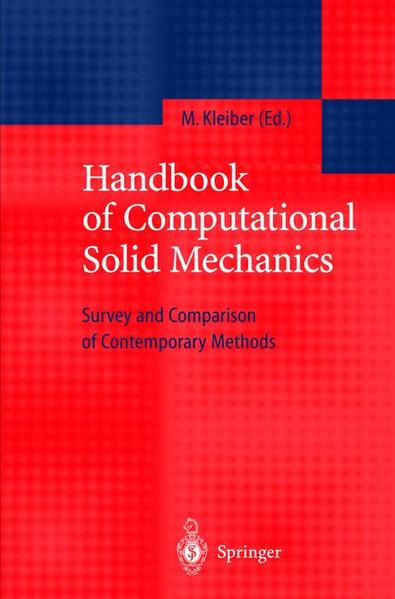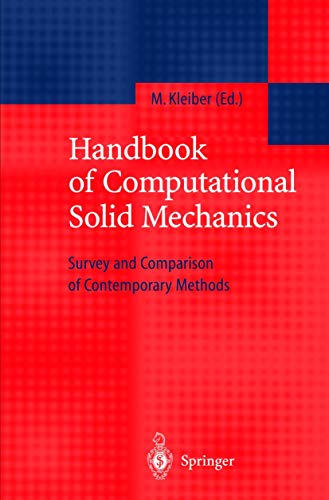
ISBN: 9783540628620
The objective of this book is to thoroughly document and discuss the influence of the most important computer-oriented techniques on formulating and solving boundary-value problems typica… Mehr…
| BetterWorldBooks.com used in stock. Versandkosten:zzgl. Versandkosten. Details... |

1998, ISBN: 9783540628620
Gebundene Ausgabe
Springer, Gebundene Ausgabe, Auflage: 1, 780 Seiten, Publiziert: 1998-08-20T00:00:01Z, Produktgruppe: Buch, Informatik, IT-Ausbildung & -Berufe, Computer & Internet, Kategorien, Bücher, K… Mehr…
| amazon.de Versandkosten:Die angegebenen Versandkosten können von den tatsächlichen Kosten abweichen. (EUR 3.00) Details... |

Handbook of Computational Solid Mechanics Survey and Comparison of Contemporary Methods - gebrauchtes Buch
1998, ISBN: 9783540628620
[PU: Springer Berlin], Gebrauchs- und Lagerspuren. Aus der Auflösung einer renommierten Bibliothek. Kann Stempel beinhalten. 366290/203, DE, [SC: 0.00], gebraucht; gut, gewerbliches Ange… Mehr…
| booklooker.de |

Handbook of Computational Solid Mechanics: Survey and Comparison of Contemporary Methods. - gebunden oder broschiert
1998, ISBN: 9783540628620
[PU: Springer], 780 p. 16,5 x 4,4 x 24,1 cm, hardcover. Like new. ISBN: 9783540628620, DE, [SC: 0.00], gewerbliches Angebot, [GW: 1035g], Offene Rechnung, PayPal, Internationaler Versand
| booklooker.de Wissenschaftliches Antiquariat Thomas Haker e.K. Versandkosten:Versandkostenfrei, Versand nach Deutschland. (EUR 0.00) Details... |

Handbook of Computational Solid Mechanics: Survey and Comparison of Contemporary Methods. - gebunden oder broschiert
1998, ISBN: 9783540628620
[PU: Springer], 780 p. 16,5 x 4,4 x 24,1 cm, hardcover. Like new. ISBN: 9783540628620, DE, [SC: 0.00], gewerbliches Angebot, [GW: 1035g], PayPal, Offene Rechnung, Internationaler Versand
| booklooker.de Wissenschaftliches Antiquariat Thomas Haker e.K. Versandkosten:Versandkostenfrei, Versand nach Deutschland. (EUR 0.00) Details... |


Handbook of Computational Solid Mechanics : Survey and Comparison of Contemporary Methods - gebrauchtes Buch
ISBN: 9783540628620
The objective of this book is to thoroughly document and discuss the influence of the most important computer-oriented techniques on formulating and solving boundary-value problems typica… Mehr…

1998, ISBN: 9783540628620
Gebundene Ausgabe
Springer, Gebundene Ausgabe, Auflage: 1, 780 Seiten, Publiziert: 1998-08-20T00:00:01Z, Produktgruppe: Buch, Informatik, IT-Ausbildung & -Berufe, Computer & Internet, Kategorien, Bücher, K… Mehr…

Handbook of Computational Solid Mechanics Survey and Comparison of Contemporary Methods - gebrauchtes Buch
1998
ISBN: 9783540628620
[PU: Springer Berlin], Gebrauchs- und Lagerspuren. Aus der Auflösung einer renommierten Bibliothek. Kann Stempel beinhalten. 366290/203, DE, [SC: 0.00], gebraucht; gut, gewerbliches Ange… Mehr…
Handbook of Computational Solid Mechanics: Survey and Comparison of Contemporary Methods. - gebunden oder broschiert
1998, ISBN: 9783540628620
[PU: Springer], 780 p. 16,5 x 4,4 x 24,1 cm, hardcover. Like new. ISBN: 9783540628620, DE, [SC: 0.00], gewerbliches Angebot, [GW: 1035g], Offene Rechnung, PayPal, Internationaler Versand
Handbook of Computational Solid Mechanics: Survey and Comparison of Contemporary Methods. - gebunden oder broschiert
1998, ISBN: 9783540628620
[PU: Springer], 780 p. 16,5 x 4,4 x 24,1 cm, hardcover. Like new. ISBN: 9783540628620, DE, [SC: 0.00], gewerbliches Angebot, [GW: 1035g], PayPal, Offene Rechnung, Internationaler Versand
Bibliographische Daten des bestpassenden Buches
| Autor: | |
| Titel: | |
| ISBN-Nummer: |
Detailangaben zum Buch - Handbook of Computational Solid Mechanics: Survey and Comparison of Contemporary Methods
EAN (ISBN-13): 9783540628620
ISBN (ISBN-10): 3540628622
Gebundene Ausgabe
Taschenbuch
Erscheinungsjahr: 1998
Herausgeber: Kleiber, Michal, Springer
Buch in der Datenbank seit 2007-05-07T08:29:38+02:00 (Vienna)
Detailseite zuletzt geändert am 2024-03-31T09:03:06+02:00 (Vienna)
ISBN/EAN: 3540628622
ISBN - alternative Schreibweisen:
3-540-62862-2, 978-3-540-62862-0
Alternative Schreibweisen und verwandte Suchbegriffe:
Autor des Buches: warszawa, michal kleiber editor
Titel des Buches: handbook computational solid mechanics survey and comparison contemporary methods
Daten vom Verlag:
Autor/in: Michal Kleiber
Titel: Handbook of Computational Solid Mechanics - Survey and Comparison of Contemporary Methods
Verlag: Springer; Springer Berlin
763 Seiten
Erscheinungsjahr: 1998-08-20
Berlin; Heidelberg; DE
Gedruckt / Hergestellt in Deutschland.
Gewicht: 1,120 kg
Sprache: Englisch
85,55 € (DE)
87,95 € (AT)
106,60 CHF (CH)
Not available, publisher indicates OP
BB; Book; Hardcover, Softcover / Mathematik/Wahrscheinlichkeitstheorie, Stochastik, Mathematische Statistik; Maschinenbau und Werkstoffe; Verstehen; B; Continuum Mechanics and Mechanics of Materials; Engineering; Computational Intelligence; Engineering, general; Classical Mechanics; Künstliche Intelligenz; Ingenieurswesen, Maschinenbau allgemein; Klassische Mechanik; BC; EA
I General Introduction.- 1 On Solving Problems of Mechanics by Computer Methods.- 2 Basic Equations of Nonlinear Solid Mechanics.- 2.1 Introductory Comments.- 2.2 Description of Strain.- 2.3 State of Stress.- 2.4 Equations of Motion.- 2.5 Constitutive Equations.- 2.6 Fundamental System of Equations for Nonlinear Mechanics of Deformable Bodies.- 2.7 Variational Formulation.- 2.8 Heat Conduction.- 3 On Approximate Solving Systems of Differential Equations.- References.- II Finite Element Method.- 1 Introduction.- 2 Selected Topics from the Mathematical Theory of Finite Elements.- 2.1 Variational Formulation.- 2.2 Regularity of the Solution. Sobolev Spaces.- 2.3 Existence, Uniqueness and Regularity Results.- 2.4 Fundamental Notions of the Mathematical Theory of Finite Elements.- 2.5 Convergence Analysis for Conforming Elements. Cea’s Lemma.- 2.6 Convergence in Norm L2. The Aubin-Nitsche Argument.- 2.7 Numerical Integration. Strang’s First Lemma.- 2.8 Nonconforming Elements. Strang’s Second Lemma.- 2.9 Steady State Vibrations as an Example of a Non-coercive Problem.- 2.10 Conclusions.- 2.10.1 Relaxing Regularity Assumptions.- 2.10.2 Summary.- 3 Fundamentals of nonlinear analysis.- 3.1 Solid Mechanics Problems.- 3.2 Heat Conduction Problem.- 4 Problems of Dynamics.- 4.1 Classification of Computer Methods Used for Analysis of Dynamic Problems.- 4.2 Formulation of Equations of Motion Using Rigid Finite Element Method.- 4.3 Eigenvalue Problem.- 4.4 Fourier Transformation.- 4.5 Numerical Integration.- 4.6 The Modal Method.- 4.7 Vibration Analysis of Systems with Changing Configuration.- 4.8 Investigation of Dynamic Stability of a Linear System.- 5 Space-Time Element Method.- 5.1 Introductory Remarks and General Relations.- 5.2 Principle of Virtual Action.- 5.3 Rectangular Space-Time Elements.- 5.4 Non-rectangular Space-Time Elements.- 5.5 Uncoupled Equilibrium Equations for Impulses.- 5.6 Non-stationary Heat Flow.- 6 Plasticity Problems.- 6.1 Forms of Constitutive Equations.- 6.1.1 Introductory Comments.- 6.1.2 Thermo-Elasto-Plasticity with Isotropic Hardening...- 6.1.3 Mixed Isotropic-Kinematic Hardening.- 6.1.4 Creep and Visco-Plasticity.- 6.1.5 Elasto-Plasticity with Damage.- 6.1.6 Large Elastic-Plastic Deformations.- 6.1.7 Rigid-Plasticity and Rigid Visco-Plasticity.- 6.2 Solving Plasticity Problems by FEM.- 6.2.1 Boundary-Value Problem of Plasticity.- 6.2.2 Finite Element Equations.- 6.2.3 Time Integration of the Constitutive Equations.- 6.2.4 The Consistent (Algorithmic) Tangent Matrix.- 6.3 Computational Illustrations.- 7 Stability Problems and Methods of Analysis of FEM Equations.- 7.1 Remarks on Stability Analysis of Mechanical Systems Equilibrium States.- 7.1.1 Loads in Stability Analysis of Mechanical Systems.- 7.1.2 Equilibrium Paths and Buckling of Structures.- 7.1.3 A More General Stability Analysis of Structures.- 7.1.4 Instability under Multiple Parameter Loads.- 7.1.5 Instability of Elastic-Plastic Systems.- 7.1.6 Further Remarks.- 7.2 FEM Equations for Structural Stability.- 7.2.1 Generalisation of FE Incremental Equations.- 7.2.2 Eigenproblems in the Buckling Analysis.- 7.2.3 Extended Sets of Equations.- 7.3 Solution Methods for Nonlinear FEM Equations.- 7.3.1 Incremental Methods.- 7.3.2 Computation of Equilibrium Paths by Incremental Methods.- 7.3.3 Methods of Reduced Basis.- 7.4 Initial Buckling and Evaluation of Solution of Nonlinear and Nonconservative Problems.- 7.5 Numerical Examples.- 7.6 Final Remarks.- References.- III Finite Difference Method.- 1 Introduction.- 1.1 Formulation of Boundary-value Problems for Finite Difference Analysis.- 1.2 FDM Discretization.- 1.3 The Basic FDM Procedure.- 2 The Classical FDM.- 2.1 Domain Discretization.- 2.2 Selection of Stars and Generation of FD Operators.- 2.3 Generation of the FD Equations.- 2.4 Imposition of Boundary Conditions.- 2.5 Solution of Simultaneous FD Equations.- 2.6 Postprocessing — Evaluation of the Required Final Results...- 2.7 Numerical Examples.- 2.8 Advantages and Disadvantages of the Classical FDM.- 3 Curvilinear Finite Difference Method.- 3.1 Introduction.- 3.2 Concept of the CFD.- 3.3 CFD Formulas for Local Partial Derivatives.- 3.4 Transformation of the Local Partial Derivatives to the Global x,y Plane.- 3.5 Remarks.- 4 FD Method Generalized for Arbitrary Irregular Grids.- 4.1 Introduction.- 4.2 Basic GFDM Version.- 4.2.1 Mesh Generation and Modification, Mesh Topology Determination.- 4.2.2 Domain Partition into Nodal Subdomains — Voronoi Tessalation — Delaunay Triangulation and Mesh Topology Determination.- 4.2.3 FD Stars Selection and Classification.- 4.2.4 Local Approximation Technique and FD Stars (Schemes) Generation.- 4.2.5 Generation of the FD Equations.- 4.2.6 Discretization of Boundary Conditions.- 4.2.7 Solution of Simultaneous FD Equations.- 5 Adaptive GFDM Approach.- 5.1 A’posteriori Error Analysis.- 5.2 A’posteriori Solution Smoothing.- 5.3 Adaptive Mesh Generation and Modification.- 5.4 Higher Order Approximation FD Solution Approach.- 5.5 Multigrid Approach.- 5.5.1 Prolongation.- 5.5.2 Restriction.- 5.5.3 Numerical Example.- 5.5.4 Multigrid Adaptive Solution Procedure.- 5.6 Remarks.- 6 On Mathematical Foundations of the FDM for Elliptic Problems.- 6.1 FDM at Regular Meshes.- 6.2 Finite Difference Method at Irregular Meshes.- 7 Final Remarks.- 7.1 Meshless Methods.- References.- IV Boundary Element Method.- 1 Introduction.- 2 Mathematical Foundations.- 2.1 Formal Outline of the Method.- 2.2 Elliptic Equations of the Second Order.- 2.3 Higher-Order Elliptic Equations.- 2.4 Examples of MBIE Application.- 2.4.1 Poisson Equation.- 2.4.2 Biharmonic Equations.- 2.4.3 Equations of Linear Elasticity.- 2.5 BEM as Finite-Dimensional Approximation of MBIE.- 2.6 Supplement.- 3 BEM in Linear Theory of Elasticity.- 3.1 BEM in Statics of Elastic Medium.- 3.1.1 Boundary Integral Equations for Static Elasticity....- 3.1.2 Finite-Dimensional Approximation.- 3.1.3 Particular Form of Volume Forces.- 3.1.4 Bodies of Revolution.- 3.1.5 Anisotropic and Heterogeneous Bodies.- 3.2 BEM in Dynamics of Elastic Medium.- 3.2.1 Boundary Integral Equations for Dynamic Elasticity...- 3.2.2 Time Step Method.- 3.2.3 Integral Transformation Method.- 3.2.4 Steady-State Vibrations in Dynamic Elasticity.- 3.2.5 Alternative BEM Formulation of Dynamic Theory for Elastic Medium.- 3.3 Boundary Element Method in Theory of Plates.- 3.3.1 Statics of Plates.- 3.3.2 Dynamics of Plates.- 3.4 Numerical Examples.- 4 BEM in Nonlinear Problems.- 4.1 Geometrical Nonlinearities.- 4.2 Physical Nonlinearities.- 4.3 Other Nonlinear Problems.- 4.4 Numerical Examples.- 5 BEM in Synthesis Problems.- 5.1 Boundary Element Method in Optimal Control Problems.- 5.1.1 Optimal Control of Constraints.- 5.1.2 Optimal Control of the Boundary.- 5.2 Boundary Element Method in Sensitivity Analysis.- 5.2.1 Boundary Element Method in Sensitivity Analysis of Statically Loaded Bodies.- 5.2.2 Boundary Element Method in Sensitivity Analysis of Dynamically Loaded Bodies.- 5.2.3 Discretization of Sensitivity Boundary Integrals with Boundary Elements.- 5.2.4 Sensitivity Analysis in Boundary Shape Optimization.- 5.3 Numerical Examples.- 6 Final Remarks.- References.- V Optimization Methods.- 1 Numerical Approaches to Structural Optimization.- 1.1 Introduction.- 1.2 Optimal Design Problem Formulation.- 1.3 Mathematical Programming Methods.- 1.3.1 Problem Statement.- 1.3.2 Unconstrained Minimization.- 1.3.3 Linearly Constrained Minimization Problem.- 1.3.4 Minimization Methods for General Nonlinear Programming Problem.- 1.4 Optimality Criteria Approach.- 1.5 Concluding Remarks.- 2 Applications of Linear Programming.- 2.1 Main Notions of Mathematical Programming.- 2.2 Matrix Model of Structure.- 2.2.1 Kinematics and Equilibrium.- 2.2.2 Constitutive Relations — Linear Elastic Model.- 2.2.3 Constitutive Relations — Rigid-Plastic Model.- 2.2.4 Elastic Analysis.- 2.2.5 Ultimate Load Analysis.- 2.3 Optimum Design of Elastic Trusses.- 2.3.1 Requirements of Civil Engineering Code.- 2.3.2 General Formulation of Optimum Design Problem.- 2.3.3 Linearized Problem.- 2.3.4 Gradient Matrices.- 2.3.5 Examples.- 2.4 Optimum Plastic Design.- 2.4.1 Ultimate Yield Factor.- 2.4.2 General Formulation of Optimum Design Problem.- 2.4.3 Coefficients of Volume Function.- 2.4.4 Formulation in Redundant Stresses.- 2.4.5 Examples.- 3 Applications of Nonlinear Programming.- 3.1 Introduction.- 3.2 Design of Minimum Weight Structure as a Nonlinear Programming Problem.- 3.2.1 Equality Constraints.- 3.2.2 Inequality Constraints.- 3.3 Optimality Criteria Method....- 3.4 Explicit Formulation of Kuhn-Tucker Necessary Conditions for Minimum Weight Structures.- 3.4.1 Essence of the Method.- 3.4.2 Minimum of Structure Weight with Account for Static, Stability and Free Vibrations Problems.- 3.4.3 Scheme of the Solution Algorithm.- 3.4.4 Numerical Examples.- 3.4.5 Solution Sensitivity to Variations of Design Variables.- 4 Discrete Programming in Structural Optimization.- 4.1 Introductory Remarks.- 4.2 Graph Representing Finite Number of All Possible Structure Volumes.- 4.3 Minimum Weight Structure Made of Catalogued Members: Concept of an Algorithm.- 4.4 Numerical Examples.- References.- VI Methods of Sensitivity Analysis.- 1 Introduction.- 2 Classification of Structural Design Variables and Parameters.- 3 Fundamental Variational Theorems.- 3.1 Virtual Work Equation.- 3.2 Theorems of Potential and Complementary Energies.- 3.3 Mixed (Hybrid) Variational Principles.- 4 Sensitivity Analysis for Varying Material Parameters.- 5 Structural Shape Variation.- 5.1 Shape Description.- 5.2 Variation of Volume and Surface Integrals.- 5.3 Sensitivity Analysis with Shape Transformation.- 6 Sensitivity Analysis for Beam Structures.- 6.1 Fundamental Equations.- 6.2 Sensitivity of Potential and Complementary Energies.- 6.3 Variation of Arbitrary Functional.- 7 Sensitivity Analysis in Static and Dynamic Thermo-elasticity.- 7.1 Static Sensitivity Analysis.- 7.1.1 Material Parameter Sensitivity.- 7.1.2 Sensitivity Analysis for Shape Variation.- 7.2 Transient and Dynamic Sensitivity Analysis.- 7.2.1 Sensitivity Analysis with Respect to Material Parameters.- 7.2.2 Shape Sensitivity Analysis for Transient Thermome-chanicai Problems.- 7.3Examples.- 8 Numerical Aspects of Sensitivity Analysis.- References.Beschreibungen, Diskussionen und Vergleiche der neuesten numerischen Methoden von Solid Mechanics.
Weitere, andere Bücher, die diesem Buch sehr ähnlich sein könnten:
Neuestes ähnliches Buch:
9783642803987 Handbook of Computational Solid Mechanics (Herausgegeben:Kleiber, Michal)
< zum Archiv...



